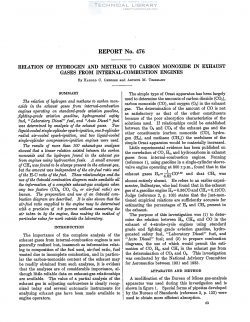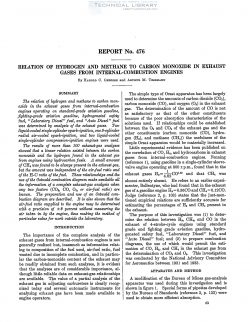naca-report-476

- Version
- 171 Downloads
- 652.21 KB File Size
- 1 File Count
- August 26, 2016 Create Date
- August 26, 2016 Last Updated
National Advisory Committee for Aeronautics, Report - Relation of Hydrogen and Methane to Carbon Monoxide in Exhaust Gases from Internal Combustion Engines

The relation of hydrogen and methane to carbon mon—
oxide in the exhaust gases from internal-combustion
engines operating on standard-grade aviation gasoline,
fighting-grade aviation gasoline, hydrogenated safety
fuel, “Laboratory Diesel” fuel, and “Auto Diesel” fuel
was determined by analysis of the exhaust gases. Two
liquid-cooled single-cylinder spark-ignitio n, one 9-cylinder
radial air-cooled spark-ignition, and two liquidcooled
single-cylinder compression-ignition engines were used.
The results of more than 100 exhaust-gas analyses
showed that a linear relation existed between the carbon
monoxide and the hydrogen found in the exhaust gas
from engines using hydrocarbon fuels. A small amount
of CE was found to be always present in the exhaust gas,
but the amount was independent of the airfuel ratio and
of the H-0 ratio of the fuel. These relationships and the
use of the Ostwald combustion diagram make available all
the information of a complete exhaust-gas analysis when
any two factors (00,, CO, 02, or airj’uel ratio) are
known. The preparation and use of an Ostwald com-
bustion diagram are described. It is also shown that the
air-fuel ratio supplied to the engine may be determined
with a precision of i2 percent without measuring the
air taken in by the engine, thus making the method of
particular value for work outside the laboratory.
The importance of the complete analysis of the
exhaust gases from internal-combustion engines is not
generally realized but, inasmuch as information relat-
ing to composition of the fuel used, air-fuel ratio, fuel
wasted due to incomplete combustion, and in particu-
lar the carbon-monoxide content of the exhaust may
be readily obtained from such analyses, it is evident
that the analyses are of considerable importance, al-
though little reliable data on exhaust-gas relationships
are available. The value of a partial analysis of the
exhaust gas in adjusting carburetors is clearly recog-
nized today and several automatic instruments for
analyzing exhaust gas have been made available to
engine operators.
| File | Action |
|---|---|
| naca-report-476 Relation of Hydrogen and Methane to Carbon Monoxide in Exhaust Gases from Internal Combustion Engines.pdf | Download |

Comment On This Post